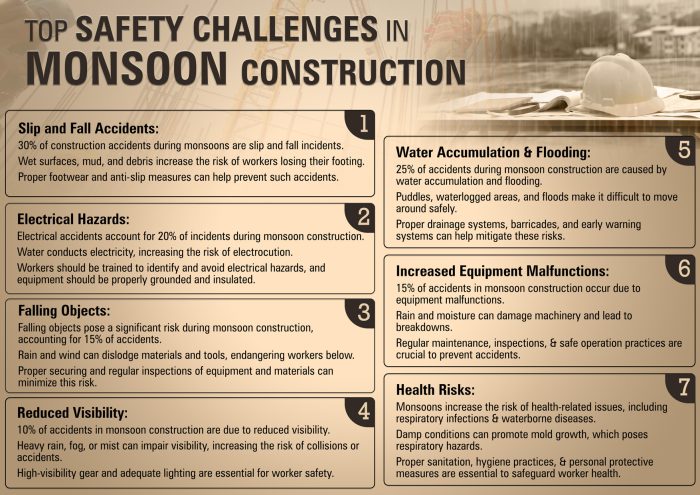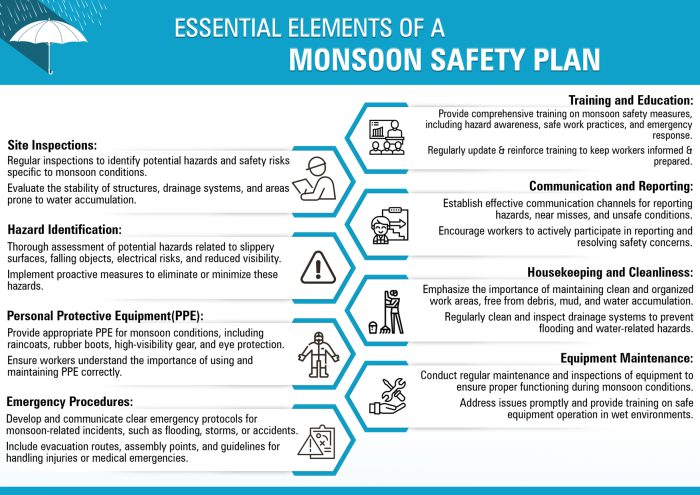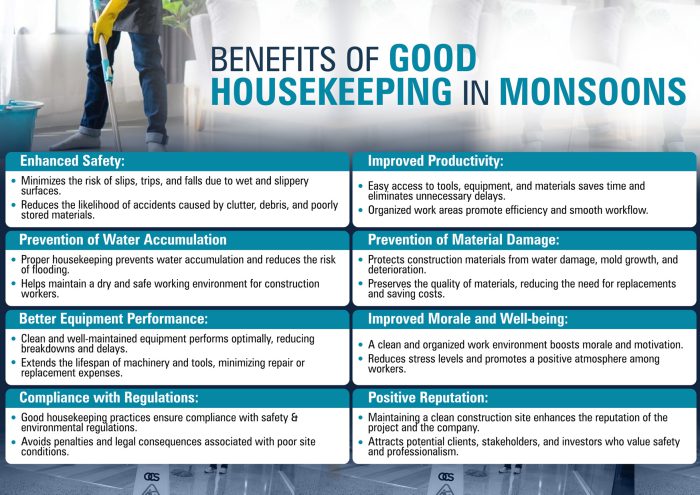Creating a Safe Working Environment for Construction Workers in Monsoons

Ah! The rains are upon us!
The monsoon season brings much-needed relief from scorching heat, but it also poses unique challenges for construction sites. Heavy rains, strong winds, and slippery surfaces increase the risk of accidents and injuries for construction workers. As responsible stakeholders in the construction industry, it is essential to prioritize the safety and well-being of our workers during this season. In this blog, we will explore practical strategies and best practices to create a safe working environment for construction workers in the monsoon.

Understanding Monsoon Hazards: Risks Faced by Construction Workers
Before embarking on the implementation of safety measures, it is of utmost importance to have a comprehensive understanding of the diverse hazards that the monsoon season poses at construction sites. This heightened awareness will enable us to develop effective safety plans that can safeguard the well-being of our construction workers during this challenging time.
Slippery Surfaces: One of the primary hazards during the monsoon season is the presence of slippery surfaces at construction sites. Heavy rainfall can lead to the accumulation of water on walkways, scaffolding, and other work areas, making them dangerously slippery. Workers may lose their footing, leading to slips, trips, and falls that can result in injuries varying in severity.
Flooding: Monsoon rains are notorious for their intensity, often leading to sudden and heavy flooding. Construction sites, particularly those in low-lying areas, are susceptible to becoming inundated with water. Floodwater poses an immediate threat to worker safety, potentially leading to drowning incidents or even structural instability.
Unstable Structures: The constant onslaught of rain can weaken construction structures over time, compromising their stability and integrity. Foundations may become waterlogged, and soil erosion could lead to subsidence or sinkholes. Such unstable structures pose a significant risk to the safety of workers and could result in catastrophic accidents.
Falling Objects: Strong winds accompanying monsoon rains can dislodge or destabilize objects on construction sites, turning them into potential hazards. Tools, materials, or debris may fall from heights, endangering workers below. Properly securing all objects at elevated locations is crucial to mitigating the risk of falling objects.
Electrical Hazards: Electrical equipment and wiring on construction sites can be a grave concern during the monsoon season. Water and electricity are a dangerous combination, and exposed electrical components can cause electric shocks, leading to severe injuries or fatalities. Inspecting and adequately safeguarding all electrical installations is imperative for worker safety.
Weatherproofing Strategies & Developing a Monsoon Safety Plan
Weatherproofing is a key aspect of ensuring worker safety during the monsoon. Implementing protective measures for construction sites such as covering open areas, securing loose materials, and reinforcing structures can help prevent accidents caused by rain and wind.

Developing a Monsoon Safety Plan for Construction Workers is a crucial aspect of ensuring their well-being and mitigating potential risks during this challenging season. To create an effective safety plan, consider the following pointers:
Hazard Identification: Begin by conducting a comprehensive assessment of the construction site to identify all potential hazards associated with the monsoon. This includes slippery surfaces, flooding-prone areas, unstable structures, falling object risks, and electrical hazards.
Weather Monitoring: Keep a close eye on weather forecasts and monitor rainfall patterns during the monsoon season. This information will help in anticipating heavy rainfalls and planning work schedules accordingly.
Personal Protective Equipment (PPE): Provide appropriate PPE to all construction workers, including waterproof clothing, non-slip boots, helmets with face shields, and other gear necessary to protect them from monsoon-related hazards.
Training and Education: Educate workers about the risks specific to the monsoon season and conduct regular training sessions on safety protocols, emergency procedures, and the proper use of PPE.
Site Preparation:Implement weatherproofing strategies such as covering open areas, securing loose materials, and reinforcing structures to minimize the impact of heavy rains and wind.
Drainage and Erosion Control: Ensure the construction site has a robust drainage system to prevent water accumulation and flooding. Implement erosion control measures to safeguard against soil erosion and its potential impact on site stability.
Regular Inspections: Conduct frequent inspections of structures, scaffolding, and equipment to identify and address any weaknesses or potential safety issues caused by the monsoon weather.
Safety Signage and Warnings: Install clear and visible safety signage throughout the construction site, warning workers of potential hazards and indicating safe routes during the monsoon.
Collaborative Efforts: Foster open communication and collaboration between contractors, site supervisors, and workers to share safety concerns, feedback, and ideas to improve the safety plan.
Protective Gear for Wet Weather: Outfitting construction workers with appropriate protective gear is vital during the monsoon season. Waterproof clothing, non-slip boots, and helmets with face shields can shield them from rain and potential hazards. Adequate rain gear can significantly improve worker comfort, visibility, and overall safety during their tasks.
Structural Inspections for Monsoon Preparedness
Conducting thorough inspections of the construction site’s structures before the monsoon season is an indispensable aspect of ensuring worker safety and preserving the integrity of the construction project. Identifying potential weak points and promptly addressing them can significantly reduce the risk of accidents, collapses, or structural failures induced by the heavy rains and flooding that often accompany the monsoon.
Pre-Monsoon Structural Assessment: Before the onset of the monsoon, enlist the services of qualified structural engineers to conduct a detailed assessment of all construction elements, including foundations, columns, beams, walls, and roofs. This evaluation will help identify any existing vulnerabilities that may be exacerbated by the wet weather.
Evaluating Foundation Stability: The foundation is the backbone of any structure, and its stability is critical. Assessing the foundation’s ability to withstand increased moisture levels and potential soil erosion during the monsoon is essential. Addressing foundation issues proactively can prevent significant structural problems later on.
Reinforcement and Waterproofing: Based on the inspection findings, reinforce critical structural elements that show signs of weakness. This may involve additional bracing or strengthening measures to improve their load-bearing capacity. Additionally, apply waterproofing treatments to vulnerable areas to protect against water seepage and dampness.
Checking Drainage Systems: Ensure that all drainage systems, including gutters, downspouts, and stormwater drains, are clear of debris and adequately functional. Proper drainage is vital for diverting rainwater away from the foundation and construction site, reducing the risk of water-related damage.
Roof Inspection: Examine the roof for any signs of leaks, damaged or missing tiles, or inadequate waterproofing. Promptly repairing any issues found will help prevent water infiltration and potential structural damage within the building.
Scaffolding and Temporary Structures: Inspect all scaffolding and temporary structures, such as formwork and shoring, to ensure they are secure and capable of withstanding the monsoon weather. Reinforce and stabilize them if needed to prevent collapses that could endanger workers.
Soil Erosion Mitigation: Implement measures to prevent soil erosion around the construction site. Installing retaining walls, erosion control blankets, or vegetation can help stabilize the soil and protect against slope failures.
Ongoing Monitoring: Continuously monitor the construction site throughout the monsoon season. Regular inspections during heavy rains and after storms can help detect any new structural vulnerabilities or damages that may require immediate attention.
Promoting Good Housekeeping
Slips, trips, and falls are common accidents at construction sites during monsoon season. To minimize these incidents, employers should ensure that walkways and work areas have adequate traction and are free from debris or water accumulation. Regularly inspecting and maintaining the site’s infrastructure and using warning signs can also help prevent such accidents.

Training and Education for Monsoon Safety
Education is a powerful tool in ensuring worker safety. Providing comprehensive training to construction workers about monsoon-specific safety protocols, emergency procedures, and the proper use of protective equipment can empower them to make informed decisions and respond effectively in challenging conditions.
Utilizing educational tools such as animated videos and eLearning can significantly enhance worker safety training. By offering comprehensive training through these interactive mediums, construction workers can gain valuable insights into monsoon-specific safety protocols, emergency procedures, and the correct usage of protective equipment.
Animated videos can visually illustrate potential hazards and safety measures, making the training more engaging and easier to comprehend. eLearning platforms enable workers to access training materials at their convenience, promoting continuous learning and reinforcing their knowledge. Empowering workers with this knowledge equips them to make informed decisions and respond effectively in challenging monsoon conditions, ensuring a safer working environment for all.
Collaborative Efforts for Safety
Ensuring worker safety in the monsoon is a collective responsibility. Contractors, site supervisors, workers, and management should collaborate closely to identify risks, address concerns, and implement safety measures. Encouraging open communication channels can lead to more effective safety solutions.
Environmental Impact and Sustainable Practices
Amid safety concerns, it is also essential to consider the environmental impact of construction practices during the monsoon season. Implementing sustainable strategies, such as rainwater harvesting and erosion control measures, can contribute to a safer and eco-friendly construction site.
Best Practices from Real Projects
Learning from successful case studies and real-life examples can be invaluable. Highlighting projects that effectively managed monsoon-related safety challenges can inspire others to adopt similar practices and foster a safer construction industry.
Future Perspectives and Innovations
Innovation plays a significant role in improving worker safety. Exploring emerging technologies, such as drones for site inspections and wearable safety devices, can enhance monsoon safety practices in construction. Being proactive in adopting new solutions will benefit workers and the industry as a whole.
Conclusion
The monsoon season demands heightened attention to construction worker safety. By understanding the hazards, implementing weatherproofing strategies, providing protective gear, and prioritizing preventive measures, we can create a safe working environment for construction workers during the monsoon. Education, collaborative efforts, and sustainable practices are key factors in maintaining safety standards. Let us work together to ensure the well-being of our construction workforce, even in challenging weather conditions.



Very nice information! Creating a safe environment for your workers is very important. Thanks for sharing such wonderful information here. It will be very helpful.